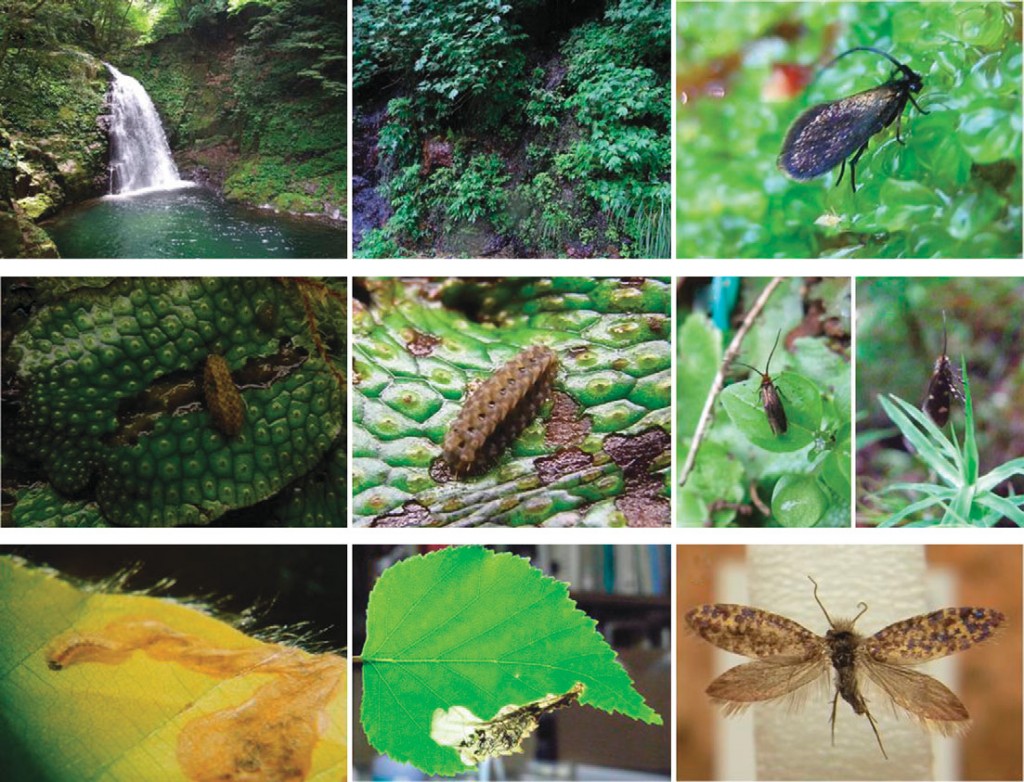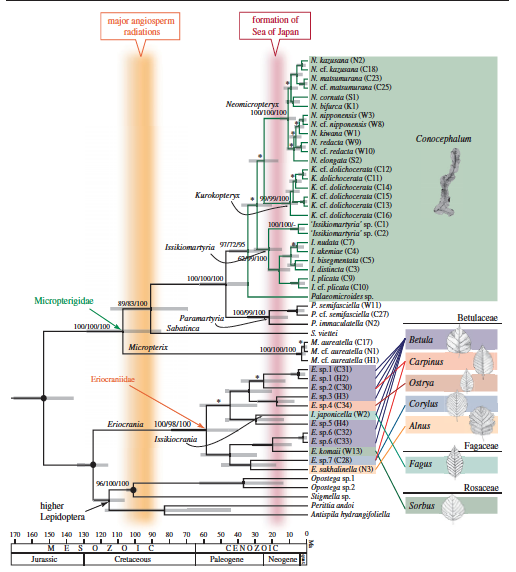![]() Свако је вероватно упознат са стандардним моделом за мољца или БУТТЕРФЛИ – а сламе као рило да допру нектар скривени у цвећу. Велика већина Лепидоптера се диверзификовала заједно са зрачењем биљака критосемењача, постане један од најразноврснијих и обилне налога живота на Земљи. This paradigm however does not apply to the Micropterigidae, који представљају не само највише базалне порекло од Лепидоптера, али су једна од три породице које су задржане мандиблес за млевење полена или спора и ослањају се на бриопхитес, труљења органске материје или гљивице као ларве домаћина. Prior assumptions as to the diversity of this group were based on the vast age of the lineage (110 милион година) и гомилање старих родова. А Недавна папир на јапанским врсте of Micropterigidae by Yume Imada and her colleagues at Kyoto University provides evidence to the contrary and applies molecular techniques to test the hypothesis of allopatric speciation without niche shift.
Свако је вероватно упознат са стандардним моделом за мољца или БУТТЕРФЛИ – а сламе као рило да допру нектар скривени у цвећу. Велика већина Лепидоптера се диверзификовала заједно са зрачењем биљака критосемењача, постане један од најразноврснијих и обилне налога живота на Земљи. This paradigm however does not apply to the Micropterigidae, који представљају не само највише базалне порекло од Лепидоптера, али су једна од три породице које су задржане мандиблес за млевење полена или спора и ослањају се на бриопхитес, труљења органске материје или гљивице као ларве домаћина. Prior assumptions as to the diversity of this group were based on the vast age of the lineage (110 милион година) и гомилање старих родова. А Недавна папир на јапанским врсте of Micropterigidae by Yume Imada and her colleagues at Kyoto University provides evidence to the contrary and applies molecular techniques to test the hypothesis of allopatric speciation without niche shift.
Аутори отпутовао 46 localities across the Japanese archipelago and collected all 16 познате ендемске врсте, неколико нових врста, а врло вероватно нови род. Finding these moths in the wild is not all that difficult if you know how to find the habitat and how not to fall off slippery rocks; али када не пронађете место на мољци може бити у изобиљу. Micropterigidae are unsurprisingly associated with their bryophytes, који се јављају у влажним стаништима дуж потока и река. The very nature of a minute and slow moving animal in isolated pockets lends itself to allopatric speciation. Many microlepidoptera barely fly off of their host plant and even when they do they are not known for long distance dispersal. While the majority of genera and species are completely isolated across Japan there are a few instances where the genus Парамартириа occurs within populations of Иссикиомартириа. While it is unknown precisely how these species might partition their host resources it is very likely to be a temporal difference in life-cycles. Here in California there is a vastly confusing complex of Аподемиа butterflies that comprise a handful of species and (наравно) подврста које су подељене на истој фабрици од пролећа и јесени сезоне узгоја.
Импресивно, every micropterigid collected as larvae were found only on the Цоноцепхалум цоницум врста крстасти копитњак, упркос постоји и до четрнаест других бриопхите врста доступних у истом станишту. It had been long understood that the Asian Micropterigidae fed on liverworts, али степен њиховог домаћина специфичности никада нису квантификовани. Feeding behavior appears to be the same across all of the surveyed species, са гусеницама испашу дуж врха бриопхитес конзумирању горње слојеве ткива.
Филогенетски анализа ЦОИ, 18С и ЕФ-1α гени генерише високо подударне стабла коришћењем више аналитичких метода. It appears that the endemic Japanese genera and the Conocephalum исхране стратегију чине добро подржан монопхилетиц клада (у зеленом). Укратко, the radiation of the host-specific Micropterigidae coincide with the separation, подизање, грубо и изолација јапанске копнена 20 Пре милион година. It could not have been difficult to propose the hypothesis that the diversity of the Japanese Micropterigidae could only be as old as the island itself; and it’s also an accepted fact today that allopatric speciation happens more commonly than once thought. But quantifying these theories and explaining how and why this happens is exactly what science is about.
Књижевност Цитед
Имада И, Кавакита, & Като М (2011). Аллопатриц дистрибуција и диверсификација без ниша смене у бриопхите-храњења базалне мољаца лозе (Лепидоптера: Мицроптеригидае). Зборник. Биолошке науке / Краљевско друштво, 278 (1721), 3026-33 ПМИД: 21367790
Сцобле, МЈ. (1992). Лепидоптера: Форма, функција, и различитост. Окфорд Унив. Притиснути.



Interesting. Note that the single species [to my knowledge] of Micropterygidae in the western US, Epimartynia pardella, also feeds on Conocephalum conicum. [unpublished obs.] Don’t know if it nests within the Japanese species, but I’d question that the japanese species had to differentiate within the confines of the present archipelago…